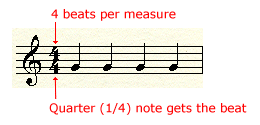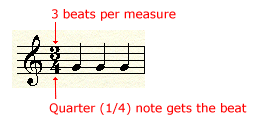Understanding Time Signatures When Reading Music
Another “signature” on the staff is the time signature. It gives you information regarding how many beats are in a measure and which note value gets the beat. Read on for some tips and examples of how to understand them.
Time Signature Basics
Time signatures can be be tricky, but once you understand how to read them everything will be groovy. Looking at a time signature you'll see two numbers stacked vertically. The top number represents the number of beats in a measure and the bottom number is which note value gets the beat. For instance 4/4 means that there are 4 beats in a measure and the quarter note (1/4) gets the beat; four quarter notes per measure.

In another example we have 3/4. This means that there are three beats per measure, and the quarter note counts as one beat.

- 3/4 = Three quarter notes per measure, quarter note gets the beat.
- 4/4 = Four quarter notes per measure, quarter note gets the beat.
- 5/4 = Five quarters notes per measure, quarter note gets the beat.
- and so on…
Time signatures with a 4 on the bottom are by far the most common type. It's generally standard practice to give the quarter note the beat in most songs.
Often times, a big C is placed where a 4/4 time signature would go. This just means “common time” and is still in 4/4.
Other Time Signatures
Now you can look at any time signature with a 4 on the bottom and figure out how to count it. But, what about the time signatures that have other numbers on the bottom? Since the bottom number denotes the note value that gets the beat we just need to understand which numbers indicate which note values. Here are a few common ones:
- 6/8 = Six eighth notes per measure, eighth note gets the beat.
- 3/8 = Three eighth notes per measure, eighth note gets the beat.
- 2/2 = Two half notes per measure, half note gets the beat.
